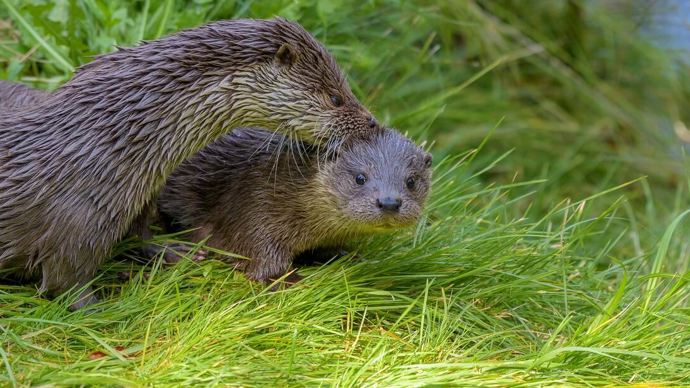Common names: common otter, Eurasian otter, European otter
Scientific name: Lutra lutra
Family: Mustelidae
Habitat: rivers, canals, lakes, wetlands, coastlines
Diet: fish, amphibians, birds, eggs, insects
Predators: none
Origin: native
An elusive carnivore well-suited to land and water. With sweet-smelling spraint and a playful nature, otters are making a comeback and are surprisingly common in waterside woodland.
Common names: common otter, Eurasian otter, European otter
Scientific name: Lutra lutra
Family: Mustelidae
Habitat: rivers, canals, lakes, wetlands, coastlines
Diet: fish, amphibians, birds, eggs, insects
Predators: none
Origin: native
Thick brown fur covers a long slender body, a thick tail and short legs. The chest and belly fur is often paler in colour. They have a broad nose and small ears, with eyes high on the head to enable better vision when they are mostly submerged in the water.
The long muscular tail and webbed feet make otters strong swimmers while sensitive whiskers and claws help them to detect and catch their prey.
One of our largest mustelids, they weigh in at 7-11kg and measure 94cm-155cm from nose to tail. On average, males are larger than females.
An otter is capable of catching prey equal to its own body weight.
Otters are carnivores that feed mostly on fish like trout, carp and eels. They happily eat amphibians, crustaceans and waterbirds like moorhens and coots too.
Sometimes they will look for food on land, selecting birds, eggs, insects and small mammals to satisfy their appetite - otters will usually eat more than 2lbs of food a day.

Credit: Raimund Linke / Alamy Stock Photo
Otters are mostly solitary except when they come together to breed. They mate year-round, though most cubs, also known as pups, are born between May and August. After a gestation period of 9 weeks, females usually give birth to 2-3 blind cubs with short grey fur. The cubs are about 12cm long and weigh about 100g.
The mother raises her cubs without help from the male. After about 10 weeks she takes them out of the holt for the first time, and a few weeks later they venture into the water for their first swim. She will protect them until they're about a year old, when they leave to make their own homes and start to breed around the age of two. Otters can live up to ten years old in the wild.
Otter pups communicate with their mother and siblings using a variety of whistling and murmuring noises.
Otters can be found throughout the UK, though with lower densities in England which was worst affected by polluted waters. Otter hotspots include the west coast of Wales and South West England.
They will live wherever there is clean freshwater with plenty of food and secluded areas of vegetation to rest and raise young. Rivers, canals and lakes are ideal, and coastlines too if there's a freshwater source nearby.
Nests known as holts are usually made in natural cavities in riverbanks, tree roots, shrubby thickets or rocky crevices. Lined with grasses, ferns, reeds and leaves, they have multiple entrances, some of which may be underwater. Some holts have more than one chamber too, which the otter may connect by digging a system of tunnels, including one to use as a latrine.
With large territories, otters use a number of resting places in areas of overgrown vegetation as well as their holt. Some they return to frequently and some only occasionally.
Otters can swim comfortably at about one metre per second.
As otters are most active at night, dawn and dusk are good times to look out for them. Follow our spotting tips for the best chance of tracking them down.
We help otters by maintaining artificial holts and allowing scrubby thickets to grow along river banks in our woods.
The return of the otter across the UK is a conservation success story. By the 1950s, the species was on the brink of extinction due to hunting, habitat destruction and chemicals leaching into watercourses. But the 1980s was a turning point. Otters were given their current protection under law, the chemicals were later banned so improving water quality, and an ongoing programme of releases increased numbers towards the more stable populations of today.
The otter has no natural predators in the UK, but pollution and road traffic accidents remain a threat.
Learn how to track elusive woodland animals with our poos and clues swatch book
Buy it now
Woodland wildlife is fading before our eyes. Please support our appeal to save rare and threatened species.
Donate now